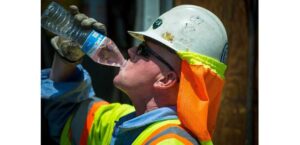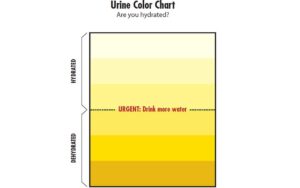During the summer, the hottest season of the year, staying properly hydrated can go a long way in helping prevent heat stress and heat injuries. Workplace dehydration is generally associated with being outside in hot, humid environments; however, dehydration can actually happen year-round in a variety of environments or conditions. It can be especially problematic for jobs that require wearing heavy PPE or are physically demanding in nature.
Ensuring proper hydration and hydration education and safety programming can help reduce the number of accidents and maintain productivity. According to the National Safety Council, the total cost of work injuries in 2020 was $163.9 billion.
Dehydration can be a huge challenge in the workplace as oftentimes, the affected individual may not even know they are dehydrated until the problem becomes serious. Anyone can experience dehydration and there are a number of causes. Remembering to drink enough water is crucial to maintain proper hydration, regardless of the work environment.
Let’s take a look at dehydration in the workplace and identify some ways to mitigate it.

source: khn.org
What are the Symptoms and Signs of Dehydration?
One of the most well-known and best ways to identify our own hydration level is by examining urine color. The darker the color of urine, the more dehydrated the person. A properly hydrated individual will have urine that is pale yellow. When a person is slightly dehydrated the urine is bright yellow and a cup or two of water will usually do the trick. If a person is severely dehydrated their urine can be very dark yellow, maybe even orange in color. This person should drink at least a liter of water.

source: elcosh.org
Urine odor can also be an indicator of dehydration. The less hydrated an individual is, the ammonia smell becomes much stronger due to the concentration of the urine.
Examining urine color or odor isn’t the most reliable way on-site to understand individual hydration levels. Here are some ways to identify when someone is not properly hydrated:
- The individual is displaying altered behavior, such as severe anxiety, confusion, or not being able to stay awake.
- Having a faintness that is not relieved by lying down, or light headedness that continues after standing for more than a couple of minutes.
- When severely dehydrated, the individual will have a weak, rapid pulse.
- Cold, clammy skin or hot, dry skin.
- In the most extreme of circumstances, loss of consciousness.
Is Staying Hydrated at Work Important?
Regardless of the type of work you do, chances are you want to perform at your peak level. Even mild dehydration impairs cognitive performance and mood. When a worker is improperly hydrated, it by definition means that they have less water in their body than they should. All those vital organs that allow us to live, need water to function properly. When the brain lacks water, the firing of synapses becomes slowed. This can in turn cause difficulty with information retention, memory recall and attention span, which are some of the most basic building blocks of good performance in the workplace. Whether on-site or in the office, having an extra cup of water or two can be highly beneficial.
How to Prevent Dehydration in the Workplace
When looking for opportunities in the workplace to help prevent dehydration, break the approach up into 3 different levels: The Worker, The Environment and The Leadership.
The Worker
Workers are the first line of defense as they know the job better than anyone else, and their own bodies. Workers should avoid alcohol, caffeinated drinks or liquids containing large amounts of sugar. Encourage your team to plan ahead by drinking water before heading into hot or exerting conditions. Make sure they are aware of the outward signs of dehydration so they can keep an eye on their teammates. They (as well as leadership) can also monitor the amount of times they or their fellow workers are using the restroom–not using it enough is a sign that they could be dehydrated. They should also be aware and discuss with their doctor or a medical professional any medications they’re taking that could affect their hydration levels.
The Environment
Any new job site (or even old!) should have a proper escalation plan in case of emergency. Outfit a work site with the proper safety equipment and make sure workers know who to call for medical help. To help mitigate dehydration, make sure workers know where water is located and how much they should drink during the day. Make sure to have regularly scheduled safety meetings to remind workers how to avoid dehydration and heat exhaustion.
The Leadership
Leadership should be properly backing, training and resourcing the work site for safety. This includes the sometimes overlooked simple things — like keeping the workforce hydrated.
Prepare workers for a hot environment by taking the necessary steps both for their physical and mental well-being. Physically prepare workers by providing a proper plan for acclimatization. Prepare the worker mentally by providing adequate training and awareness of dehydration risks and mitigation techniques. Help train workers and supervisors to look for the signals of dehydration.
Hydration tips around the Worksite
Avoid using thirst as indicator:
- When a worker begins to feel thirsty, they’ve already lost around 2-4% of their hydration level.
- Workers should drink cool water, 5 to 7 ounces, every 15 to 20 minutes. In total, aim to drink between 8 and 10 glasses of water each day. Though pure water is the best choice, augmenting with a sports drink is also a good rehydration choice.
Consider Adding Electrolytes
- During manual labor, workers will sweat and lose electrolytes. Hydrating with water is important, but consider supplementing water with sports drinks or other beverages that can help replenish lost electrolytes.
Avoid Specialty Drinks:
- Drinks that contain high amounts of caffeine such as coffee or soda increase urine output and make you dehydrate fasters. Alcoholic beverages not only increase dehydration but for a number of reasons should not be consumed right before, during or after work.
Bodily Awareness:
- Stop hot work immediately if signs of dizziness, lightheadedness or fatigue occurs.
- Drink before, during and after physical labor to replace body fluid lost through perspiration.
Plan ahead:
- Try to anticipate conditions that will increase the need for water, including high temperature, humidity, wearing of protective clothing and difficulty of work. If able, replace sweat-saturated clothing with dry clothing as soon as possible. Sweat-saturated clothing hampers your body’s cooling ability by making sweat evaporation more difficult.


